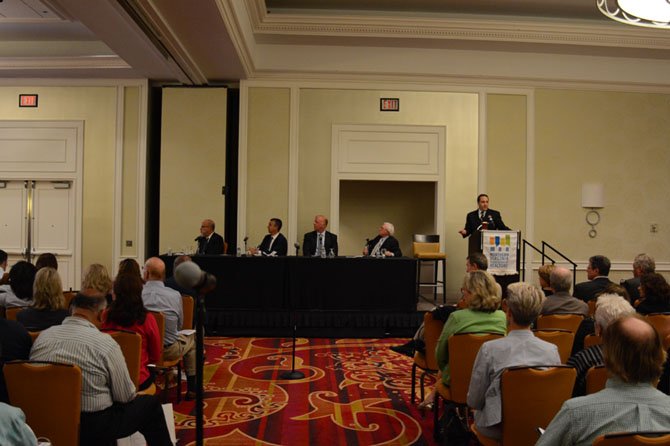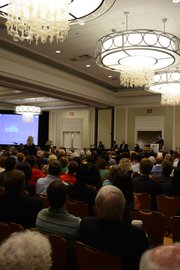Panelists (from left) at the 2014 NVAR Economic Summit: Mitchel Kider, Dr. Michael Frantoni, James Dinegar and David Versal. Photo by Tim Peterson.
“There’s no question the primary economic driver of this region has always been Uncle Sam,” said David Versal, senior research associate at the George Mason University Center for Regional Analysis. “That said, we’re not Detroit.”
That was a year ago, when Versal addressed members of the Northern Virginia Association of Realtors at their economic summit held in George Mason University’s Mason Inn.
At this year’s summit, his past remarks came back to haunt him, if not the whole room. “In 2013, job growth ground to a halt,” he said at the event last Thursday. “July [2013] to July [2014], net was about 20,000 jobs in our region. Who do we come closest to?”
The stunned conference hall full of Realtors, seeing his slide, answered in unison: “Detroit.”
Versal was back again for 2014, along with discussion moderator Kenneth Harney, author of the syndicated column “The Nation’s Housing.”
New panelists included: James Dinegar, president and CEO for the Greater Washington Board of Trade; Dr. Michael Frantoni, chief economist and senior vice president of research and industry technology for the Mortgage Bankers Association, and Mitchel Kider, chairman and managing partner for Weiner Brodsky Kider PC.
THE THEME of this year’s summit was “Housing Hangover: Recession Ripple Persists in 2014: Jobs, Confidence, Mortgages (+ Aspirin) Fuel Recovery.”
Each panelist brought a different perspective to the central concept that no, the recession is not over, growth is slow and home sales are flat; but yes, the recovery is on and as long as home buyers, sellers and Realtors alike keep in front of the economic and regulatory changes taking place, things are looking up. We’re all still here.
Versal echoed his callout from last year, that since 2010 government spending cuts have decimated the Washington D.C. metro area. “We lost over $11 billion in federal procurement,” he said, referencing the massive contracting industry, “just in 3 years; $11 billion that was in our economy in 2010 that is no longer. This is on top of the 20,000 jobs we've removed.”
One true gainer in jobs over the same period, he said, has been hospitality — specifically restaurant jobs. However even though those jobs help pad the not-Detroit figure, they don’t exactly help a housing market that’s light on top-end inventory and lacking any semblance of a middle.
“Ask yourselves as Realtors: Are people buying $6-7-800,000 houses in this region people who work in restaurants? Unless they own the restaurant probably not,” said Versal.
According to Versal, Northern Virginia isn’t creating enough jobs paying in the $40- to $70,000 range to stimulate growth in the market’s midsection.
But that’s not all: Another factor — and a continuation from 2013’s remarks — keeping the market from balancing out is the lack of adequate housing construction.
Or rather, construction of homes for purchase. Versal said half of what’s being built is rental property, which doesn’t produce sales and doesn’t help the sagging middle.
But the regional analyst did point out a few bright spots, looking forward. In the next three to four years, Versal predicts, the D.C. metro region will be creating 50-60,000 jobs again, like it was 10 years ago — which should drive demand for housing. However this growth, he stressed, will be borne by the private sector, not the federal government.
James Dinegar of the Greater Washington Board of Trade took that optimism and ran with it, giving a speech that hyped the many “cool factors” of the D.C. metro region.
He cited Forbes magazine recently voting that area “America’s Coolest City.”
He cited things like Bao Bao the infant panda at the National Zoo, Robert Griffin III, Maryland joining the Big Ten major college football conference (and more importantly the Big Ten Network) and capital bike-sharing program that leads the nation in users per capita.
He cited things like numerous top tier universities, the juggernaut of cyber job-creating — NSA at Fort Meade — and being the hospitality capital of the world.
Things that, presumably, should be drawing young, family-oriented and financially stable professionals to the area, or keeping them here.
“You have to get your head around the Big Ten,” Dineagar gave an example. “The BTN reaches 52 million households. We're not exposed to the Midwest the way we have been in the ACC. We're on radar screens now we haven't ever been on.”
According to Dr. Michael Frantoni of the Mortgage Bankers Association, having a greater overall pull would be helpful to attract fresh capital to the nation’s capital. The national trend, he said, is decreased mobility: Recent census data shows that aside from family-related moves, people are staying put more than they used to.
“Moving to a better neighborhood? If anything, people are moving to save money. But they’re not aspirational movers,” he said.
Or maybe they are aspirational movers, but are saving money by living with their parents. That group would be the mercurial, hard to put a finger on, mid-20s to mid-30s bracket referred to as “millennials.” And they’re a key group, being well situated with academic and professional experience to fill the $40-$70,000 a year private sector jobs Versal said should be driving the regional economy going forward.
However, said Frantoni, “They’re different in all kinds of ways. They get married later, have children later, come home later. Everything is later. We don't know why.”
A MILLENNIAL’S HESITANCY to buy property probably doesn’t have much to do with the projected rise in interest rates from 4.3 percent for a 30-year fixed mortgage rate in 2013 up to 5 percent in 2015. But it may have something to do with the fact that student loan debt has ballooned in the last decade from $200 billion to over $1 trillion, according to Frantoni.
None of the panelists expects dramatic changes in the next several years. We’re off the roller coaster, they all concurred. We’re still here.


